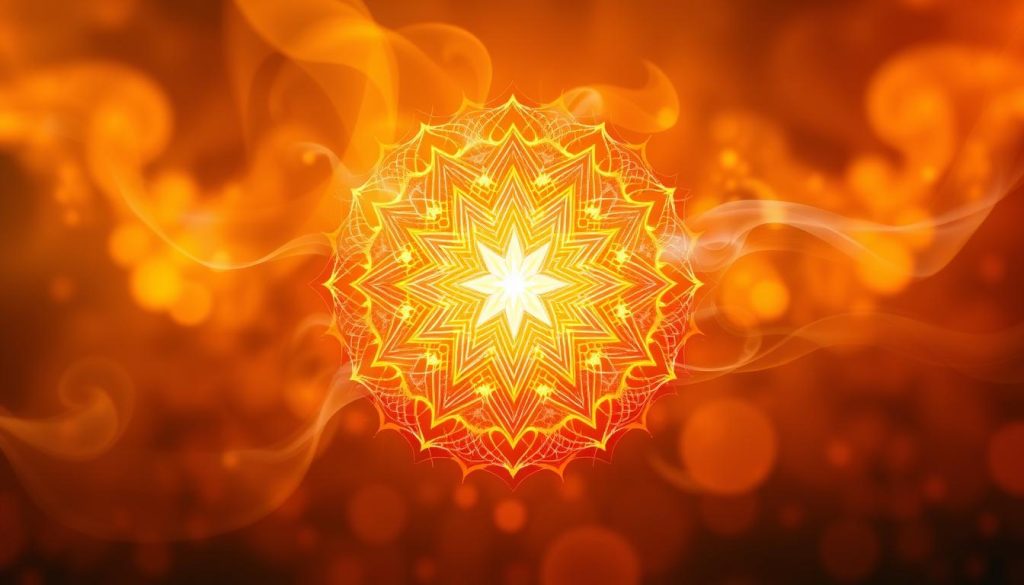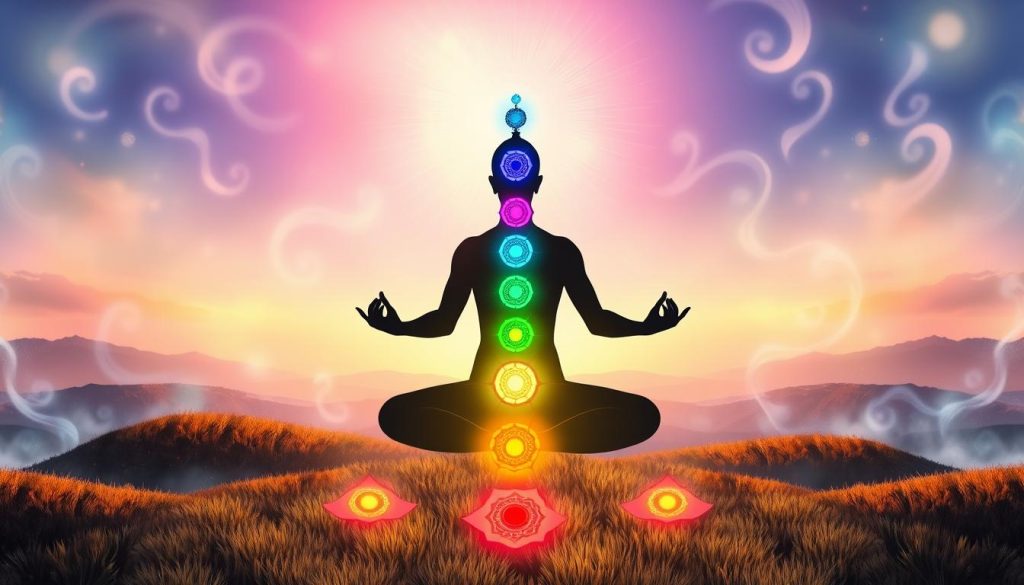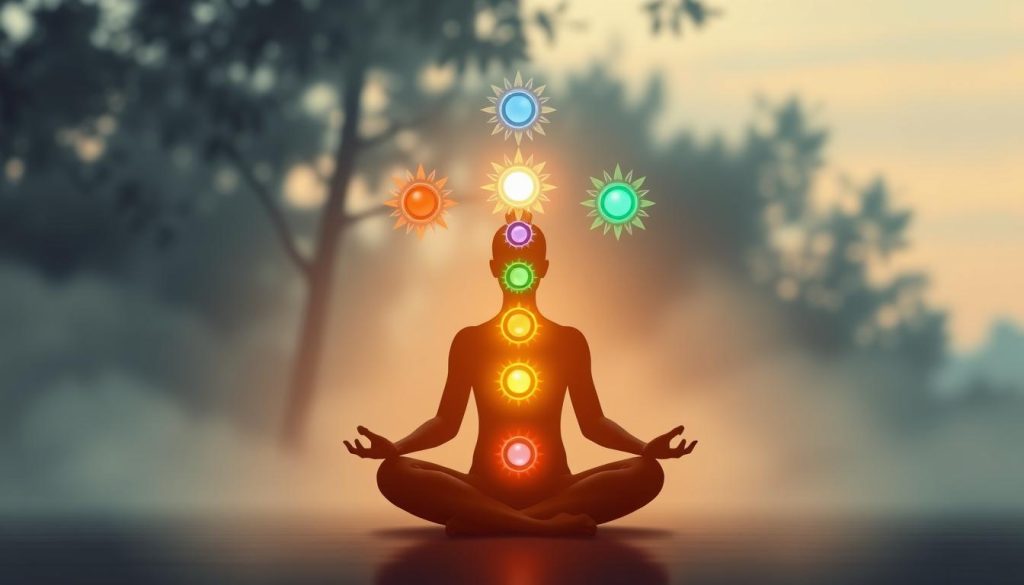Welcome. We open a friendly map of subtle hubs that run along the spine. These guides link glands, emotions, and movement. They help us feel steadier in the body and mind.
No fluff here. This intro mixes Vedic roots with modern somatic tips. Breathwork, simple poses, sound, color, and mindful eating are shown as short, practical steps you can try each morning.
We offer a warm, curious stance. Think of this as a co-exploration: small tests, easy wins, notes on health and awareness. You will learn a clear ladder from base up to crown, how each spot shapes choices, mood, and resilience.
What’s ahead: clear definitions, signs of imbalance, quick practices, and a gentle plan you can repeat. Ready to notice subtle shifts and feel more present in daily life?
What Are Chakras? The Body’s Energy Centers from Base Spine to Crown
Chakras are like a vertical map of subtle life running along the spine. They are subtle energy centers that sit in the astral layers of the human body, from the root at the base to the crown above the head.
Ancient texts name countless points, but a practical path highlights seven primary centers: Muladhara (Root), Svadhishthana (Sacral), Manipura (Solar Plexus), Anahata (Heart), Vishuddha (Throat), Ajna (Third Eye), Sahasrara (Crown).
These centers help distribute prana and shape mood, posture, and choice. You won’t see them on scans, yet you can sense tightness, openness, or shifts during breathwork.
The sushumna nadi is the central channel through the spine where awareness can rise. Think of it as the quiet column that links each chakra and guides inner movement.
Quick invite: place a hand on your low back or belly. Notice where you feel tight or roomy along the center line. No fixing—just listen.
How Chakras Work and Why They Matter for Health and Awareness
Think of each subtle hub as a smart router that moves life force where the body needs it. Each chakra distributes the five pranas into local regions, guiding glands, organs, nerves, and tissue.

When a center runs slow we feel drag: fatigue, tightness, poor digestion. When it runs hot we get racing thoughts, tension, or burnout. Balance aims for steady flow, not maximum speed.
Feeling steadier shows in simple markers: calmer breath, clearer focus, better sleep, and steadier digestion. These small wins point toward higher levels of awareness and subtle shifts in consciousness.
Practical tools tune the system. Breathwork, asanas, mindful food, mudras, and short meditation sessions help restore coherent distribution. The mind and posture shape rhythm too, so small changes add up quickly.
We invite curiosity: notice symptoms as signals. Respond compassionately. A minute of the right technique often brings your inner routers back online and helps you feel more present in the world.
The 7 Chakras at a Glance: Colors, Elements, and Core Themes
Imagine a color wheel that points to what your body and mind ask for. This quick map pairs color and element with a core life theme so you can spot which center wants attention.
Root chakra — Red / Earth: safety, grounding. Ask: am I steady?
Sacral chakra — Orange / Water: emotions, creativity, sensuality. Ask: am I feeling?
Solar plexus chakra — Yellow / Fire: willpower, confidence. Ask: am I choosing?
Heart chakra — Green / Air: love, compassion. Ask: am I open?
Throat chakra — Blue / Sound: truth, expression. Ask: am I speaking?
Third eye — Indigo / Light: intuition, insight. Ask: am I seeing?
Crown chakra — Violet or White / Thought: unity, presence. Ask: am I connected?
Quick tip: mirror the visible light spectrum when you pick clothing, lighting, or wallpapers. Use a small color cue to prime focus for the day. A single hue can nudge your energy toward clearer balance.
A Complete Guide to the 7 Chakras: Symbols, Locations, and Signs
We trace each subtle center with symbol, sound, and location so you can practice with confidence.
Root chakra (Muladhara): four‑petaled lotus with a square/triangle, red, earth. Location: base of the spine. Mantra: Lam. Balanced brings stability; imbalance brings fear and insecurity. Try Mountain or Tree pose to ground.
Sacral chakra (Svadhishthana): six petals, circles and crescent, orange, water. Location: below the navel. Mantra: Vam. Balanced brings joy and creativity; imbalanced brings irritability or obsession. Try Triangle or Crow.
Solar plexus chakra (Manipura): ten‑petal lotus with a triangle, yellow, fire. Location: solar plexus. Mantra: Ram. Balanced brings confidence and personal power; imbalance can show as digestive issues or perfectionism. Try Forward Bend, Cobra, or Bow.

Heart chakra (Anahata): intersecting triangles, green, air. Location: chest. Mantra: Yam. Balanced brings compassion; imbalance shows jealousy or anxiety. Try Half Bridge or Fish.
Throat chakra (Vishuddha): 16 petals with inverted triangle and circle, blue, space/sound. Location: throat/thyroid. Mantra: Ham. Balanced brings honest expression; imbalance brings timidity. Try Shoulderstand or Plough.
Third eye (Ajna): two petals with an inverted triangle, indigo. Location: between the eyebrows. Mantra: Om. Balanced brings intuition; imbalance can cause headaches or ego tension. Gentle Headstand can focus this center.
Crown chakra (Sahasrara): thousand‑petaled lotus, violet/white. Location: crown of the head. Mantra: Aum. Balanced brings peace and higher consciousness; imbalance can feel melancholy or frustration. Rest in silence or a mindful Headstand.
How to Tell If Your Chakras Are Blocked or Overactive
Your body uses simple cues to tell a story about inner flow. Notice tight hips, stomach knots, a sore throat, or recurring headaches. These can point to a local chakra issue rather than just pain.
Quick signals: root chakra shows as fatigue or back pain and scarcity anxiety. Sacral chakra may show reproductive issues or numb feeling. Solar plexus chakra often appears as digestive trouble or low self‑worth.
Heart chakra can feel like chest tightness or fear of intimacy. Throat chakra shows in sore throat or fear of speaking. Third eye may bring headaches or fuzzy intuition. Crown chakra can show migraines or a drifting cynicism.
Blocked states feel shut down; overactive states feel scattered. A shaky root can ripple up and tighten the heart or stress the solar plexus. Ask short prompts: “Do I feel safe? Am I creative? Can I speak my truth?”
Try one‑minute resets: ground, sway, core fire, heart breath, hum, soft gaze, silent pause. Track patterns across the week and meet sensations as friendly data for better health and steady energy.
7 Chakras and Their Meanings: How to Balance Your Energy Daily
A short set of micro-practices can keep subtle flow steady through a busy day. We craft a five‑to‑ten‑minute morning ritual that touches each chakra with clear, kind moves.
Quick morning mix: one minute of earthing for the root, 30 seconds of hip circles for the sacral, three breaths of core fire for the solar plexus. Add a soft inhale for the heart, a gentle hum for the throat, a soft gaze for the third eye, and a silent pause for the crown.

Use color cues—shirt, phone wallpaper, or a small sticky note—to anchor attention on today’s center. Pair tiny meal tweaks: a grounding bite, a hydrating choice, a bright yellow booster. These simple shifts feed energy without fuss.
Evening check‑in: note what felt stable and where you want more flow tomorrow. Add a weekly reset that goes a bit deeper so health and life stay steady.
Mini tools: anchor words for meditation: safe, feel, choose, love, truth, see, open. Keep it light and kind—when practice fits real life, we actually keep it.
Food as Energy: Element-Balancing Nutrition for Each Chakra
Eating with intention turns a plate into a simple tool for inner balance. We match foods to element and color so a single meal steadies your flow.
Root: choose beets, root vegetables, and red apples. These base foods ground the body and feed the root chakra with earthy stability.
Sacral: eat oranges, mango, or pumpkin. Hydrating, sweet choices support creativity and the sacral center’s fluid nature.
Solar plexus: bright yellow items like pineapple, corn, and bananas fuel personal power. A sunny bite brings warmth to the plexus.
Heart: layer leafy greens, broccoli, and green apples. Greens nourish circulation and invite softness toward others and self.
Throat & third eye: blueberries, seaweed, purple grapes, eggplant, and plums refresh expression and intuitive clarity.
Crown: favor light fruits, herbal teas, and gentle fasting windows. Simple, sattvic choices clear the crown and invite quiet presence.
Practical tip: pick one color focus per day—one root, one orange fruit, one yellow booster, one green, one blue/purple, and a light item. Nature-made foods carry frequencies that support health, life, and steady energy with small swaps that add up.
Movement, Breath, Meditation, and Mudras That Restore Flow
Simple sequences move subtle currents. We start low and travel up the spine with small, kind actions. This stacked practice links the base spine to the crown in one easy pass.
Begin with Mountain or Tree for root chakra grounding. Add gentle hip circles or a Goddess sway to wake the sacral. Move into a short plank or Boat to spark core power without straining the body.
Use Breath of Fire for the solar plexus for 30–60 seconds. Then shift to slow, heart‑centered breathing to soften the chest. Finish throat work with a 30‑second hum or seed mantra to free voice tension.
Hands help. Simple mudras—thumbs and index fingers touch, open palms—act like switches that refine element flow. Add a soft drishti at the brow for third‑eye steadiness.
Advanced inversions such as Headstand and Shoulderstand are optional. Offer safe swaps: use legs on a chair or a gentle bridge for back comfort. When rushed, spend two minutes per center; on roomy days, linger where you feel called.
Color Therapy and Symbol Work: Visual Cues that Tune Your System
Visual cues act like tiny tuners. Color signals carry vibrational hints the body reads. Wear red to ground, green to soften the heart, blue to steady the throat’s voice.
Symbols are simple blueprints. A square, lotus, or triangle placed where you see it often becomes a quiet anchor. Pair a symbol with a short affirmation and you add intention to the visual cue.
Try this: pick one color, one symbol, one breath. Breathe the hue into the center you want to calm. Exhale any static. Repeat three times in moments of rush.
Use decor, jewelry, or a lamp filter as subtle reminders. Track one-week experiments: focus on the root, then the heart, then the crown, and note shifts in mood, clarity, and overall energy.
Quick checklist: red for grounding, orange for creativity, yellow for will, green for love, blue for truth, indigo for insight, violet for presence. Keep it minimal. A single glance should be enough to re-anchor and steady your world.
Sound, Frequencies, and Mantras: Tune Each Center to Its Note
Sound moves the body like wind moves leaves — subtle, direct, and instantly felt. We use short tones and simple mantras to meet each chakra with clear intention.
Try this: chant the seed mantras — Lam, Vam, Ram, Yam, Ham, Om/Aum — or hum while listening to a bowl or tuning fork. Ram fires the solar plexus chakra and lights inner courage. Yam soothes the heart. Ham clears the throat for honest voice.
Solfeggio and Pythagorean scales map well to vibrational signatures. Singing bowls and tuning forks offer gentle precision. Listen, notice where the tone sits in your body, breathe through any resistance.

Mini-protocol: two minutes per center. Play or chant. Feel, soften, and let the wave pass. Add a color or symbol while you chant for a subtle multisensory nudge.
Keep it soft and steady. Consistency beats volume. Short sound sips between tasks restore flow, boost awareness, and return the mind to its native wisdom and power.
Putting It All Together: Your Balanced Energy Journey Starts Now
, Take a small, weekly scan and let one center guide your practice.
Make a one‑page plan: scan the week, pick a center, then choose one food, one movement, one breath, one color, and one sound. Track how energy shifts in life and relationships.
Try a bottom‑up month — start at the root chakra and move toward the crown chakra. Or follow the place that calls loudest. Both paths open steady flow.
Each evening, do a five‑minute meditation: breathe the spine from root to crown, pause at the head, and rest. Ask quick reflections: what felt safe? what felt true? what felt open?
Get outside: barefoot moments, sun on skin, fresh air. Use wallpaper cues, short mantra clips, and tiny checklists so practice fits the world you live in now.
We celebrate progress over perfection. Stay curious. Little, consistent steps reveal deep wisdom and more love in daily life. Let’s walk this journey together — one breath, one center, one bright step.
